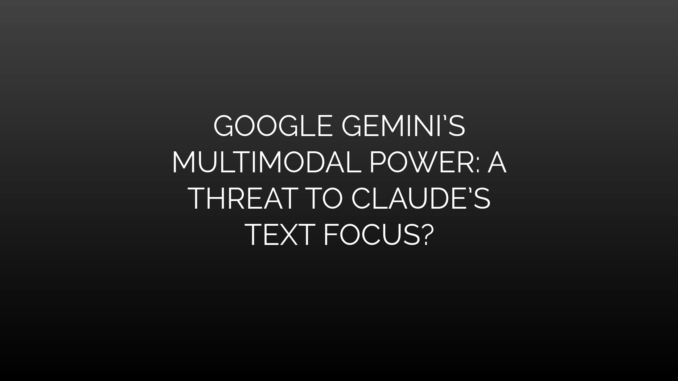
Google Gemini’s Multimodal Mastery: Is Claude’s Text Focus Under Threat?
The rapidly evolving artificial intelligence landscape is increasingly defined by a stark divergence in model design philosophies. On one side, models like Google Gemini champion multimodal capabilities, seamlessly integrating text, images, audio, and video. On the other, Claude—developed by Anthropic—doubles down on textfirst optimization, prioritizing reliability and depth in language tasks. As Gemini gains traction with its crossmodal versatility, critical questions arise: Does multimodal AI inherently undermine specialized, textfocused models like Claude? And could Gemini’s broad functionality erode Claude’s dominance in pure text workflows?
The Genesis of Gemini: Redefining Multimodality
Google Gemini entered the AI arena in 2023 not as an incremental upgrade, but as a paradigm shift. Built from the ground up for multimodal reasoning, its architecture natively processes diverse inputs—images, audio, code, and text—transforming how users query and interact with AI. Gemini’s multimodal capabilities allow it to, for example, analyze financial charts while summarizing a related earnings call transcript, interpret engineering diagrams alongside technical manuals, or generate scripts synchronized with video storyboards.
This holistic approach reflects Google’s strategic advantage: integration with its ecosystem. By interfacing with tools like Google Workspace, YouTube, and Android, Gemini leverages realtime data access for practical multimodal applications. For developers, the Gemini API simplifies building complex, mediarich workflows. Such breadth contrasts sharply with “boltedon” multimodality—models retrofitted to handle nontext inputs—often resulting in fragmented performance.
Claude: Excellence Through Text Specialization
Anthropic’s Claude carved its niche through uncompromising dedication to text. Designed around Constitutional AI principles, Claude prioritizes safety, ethical alignment, and deep contextual understanding. Unlike Gemini, Claude deliberately avoids processing images, audio, or video, focusing instead on mastering sophisticated text generation, summarization, and logical reasoning.
Claude’s innovations shine in textcentric domains:
- Long-context processing: Handling documents exceeding 200,000 tokens for legal, academic, or technical analysis.
- Reduced hallucination: Minimizing factual errors via rigorous training protocols.
- Nuanced instruction-following: Excelling at complex, multi-step prompts requiring structured reasoning.
- Ethical safeguards: Proactive content filtering and bias mitigation “baked into” responses.
For enterprises handling sensitive documents—legal contracts, medical records, policy briefs—Claude’s precision and predictability remain a compelling proposition.
Multimodality vs. Text Focus: A Strategic Clash
Gemini’s multimodal prowess introduces dilemmas for Claude:
1. The AllinOne Appeal Enterprises increasingly favor consolidated AI platforms. A Marketer using Gemini can generate ad copy, analyze campaign visuals, screen usergenerated audio feedback, and compile video reports—all within one interface. Claude, while exceptional for drafting textbased content, requires users to juggle separate tools for media tasks. In workflows demanding crossmodal cohesion—such as publishing or elearning—Gemini’s integrated approach streamlines operations.
2. Data Synthesis as Competitive Advantage Multimodal models unlock insights inaccessible to textonly systems. A gemologist might upload gem images alongside gemological reports for Gemini to grade authenticity; a journalist could crossverify footage audio transcripts with witness statements. Claude, restricted to text, lacks this verification depth.
3. Accessibility and User Experience Voice commands in Gemini allow surgeons to pull up medical protocols during operations, while its vision capabilities aid visually impaired users. Claude’s text exclusivity limits participation in such immersive experiences.
Nonetheless, Claude counters with unique strengths:
- Lower operational costs: Training and running multimodal models require immense computational resources, making Gemini expensive for high-volume text tasks.
- Specialized accuracy: Claude consistently benchmarks higher on legal bar exams, reading comprehension, and intricate Q&A.
- Niche defensibility: Highly regulated industries (e.g., finance) may prioritize text precision over multimodal breadth due to compliance risks.
Use Case Divergence: Choosing Between Gemini and Claude
The optimal model hinges on task specificity:
| Application | Preferred Model | Reason | |||| | Academic Research | Claude | Superior synthesis of longform documents. | | Media Production | Gemini | Supports scripts, storyboards, audio/video edits. | | Customer Service Chat | Claude / Gemini | Claude for nuanced text; Gemini if screenshots fall under issuances. | | Accessibility Tools | Gemini | Voice/image processing aids disabled users. |
This divergence highlights that Claude thrives in environments where text depth is nonnegotiable. Gemini dominates where crossmodal agility creates value.
The Road Ahead: Coexistence or Consolidation?
Gemini’s rise doesn’t render Claude obsolete—yet it pressures Anthropic to evolve. Three scenarios loom:
1. Claude Expands Contextual Depth Anthropic could further augment Claude’s text leadership—supporting 1Mtoken contexts for enterprise contracts or mastering industry jargon dialects. This fortifies its stronghold in law, policy, and R&D.
2. Partnerships Bridge the Gap Collaborations might emerge: Gemini handles multimodal inputs, while Claude refines text outputs. A “bestofbothworlds” pipeline maximizes efficiency.
3. Hardware Constraints Shape Adoption Energyintensive multimodal inference requires enterprise cloud support. Textfocused models like Claude benefit from lower compute demands, aiding accessibility.
Critically, Gemini’s path isn’t without challenges:
- Ethical tradeoffs: Handling visual/audio data amplifies bias and privacy risks.
- Fragmented focus: Jack-of-all-trades models risk mastering none.
Conclusion: Specialization Persists in an Expanding Ecosystem
Google Gemini poses disruption—not extinction—to Claude’s domain. Multimodal AI enriches applications requiring sensory synthesis, but Claude’s text dominance remains vital for highstakes linguistic accuracy. Rather than declaring one victor, the market will increasingly segment: Gemini as the Swiss Army knife for immersive intelligence, and Claude as the scalpel for textual excellence. Ultimately, the “threat” to Claude lies not in losing relevance, but in accelerating innovation to maintain its edge in an AI landscape where versatility captivates, but mastery endures.
Leave a Reply